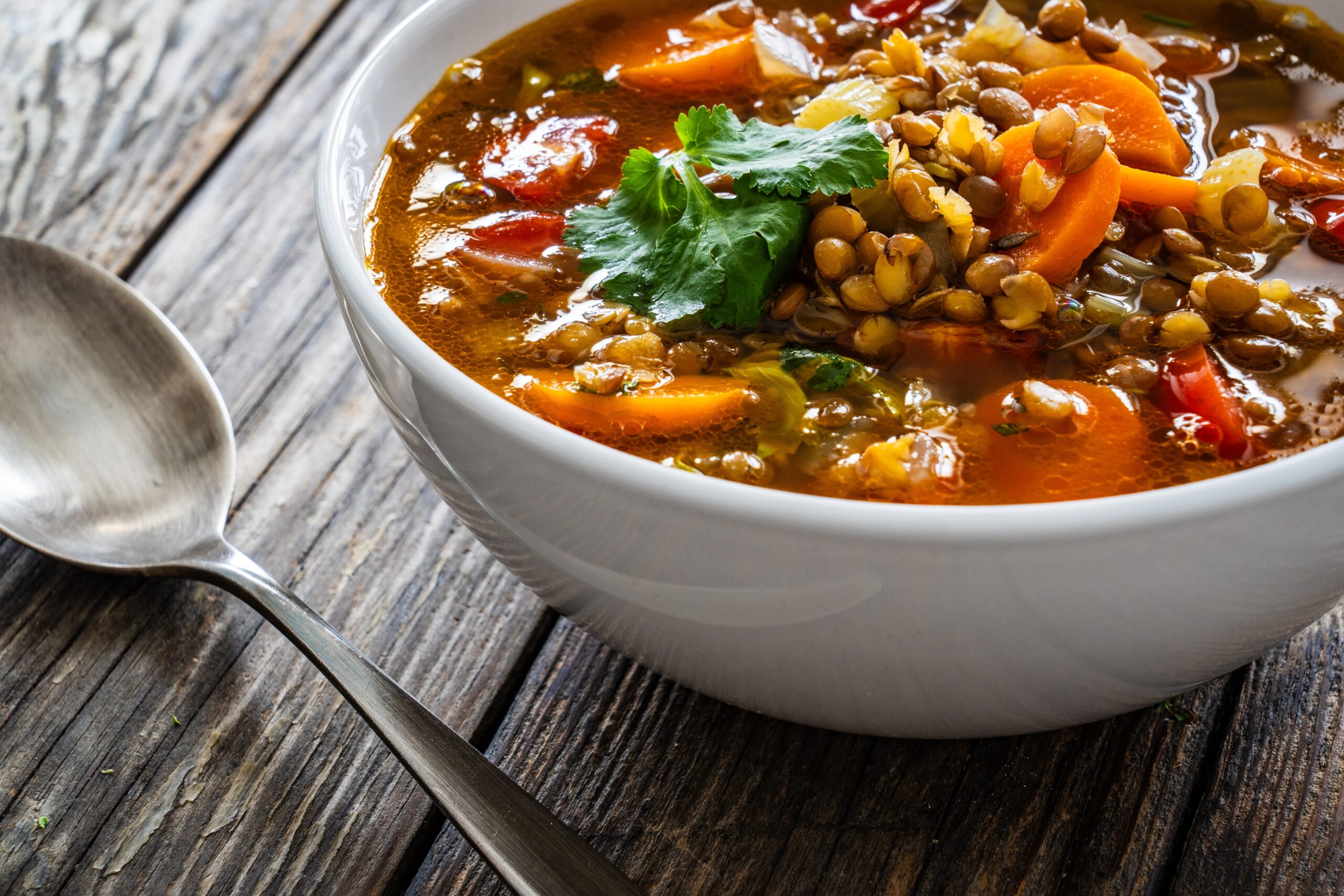
So you have made a New Year’s resolution to eat healthier, and you are trying to avoid the leftover holiday cookies. Perhaps you are feeling a little sluggish after all the holiday festivities. Here is an easy crockpot lentil soup that not only tastes delicious but is detoxifying too. The detoxifying punch of this dish comes from its nutritious base of bone broth soup.
One of the most healing ancient foods with numerous benefits. Although just recently gaining popularity, bone broth is an age-old healing remedy and has been used for thousands of years in Ayurvedic medicine. The multitude of health benefits are various and extensive, making this nourishing tonic beneficial in many different disorders. Physicians as far back as Hippocrates have associated bone broth with gut healing. And while the importance of gut health is just now starting to fill our medical journals, this knowledge is far from new in Eastern medicine. Bone broth is considered a powerful detoxification agent since it helps the digestive system expel waste and promotes the liver’s ability to remove toxins, helps maintain tissue integrity, and improves the body’s use of antioxidants. Bone broth replenishes trace minerals. Rich in glucosamine, bone broth strengthens bones and is excellent for Vata.
Modern medicine is just now rediscovering how the gut influences health and disease. Dr. Axe talks about the benefits of bone broth soup and explains that today in the Western world, the average person is exposed to an array of environmental toxins, pesticides, artificial ingredients and chemicals of all sorts. While the human body has its own means of detoxifying itself from heavy metals and other toxic exposures, it often has a hard time keeping up when flooded with an overwhelming amount of chemicals. Bone broth contains potassium and glycine, which support both cellular and liver detoxification.
Some of the ways in which bone broth boosts detoxification are by supplying sulfur (especially when you add the veggies, garlic, and herbs to your broth) and glutathione, which is a phase II detoxification agent that lowers oxidative stress. It is interesting to note that Stanford University’s Medicine Preventative Research Center has found that glutathione helps with the elimination of fat-soluble compounds, especially heavy metals like mercury and lead. One small study found that chicken bone broth may help reduce inflammation and cold symptoms when you’re sick. Another study published in Clinical and Experimental Gastroenterology found interestingly that gelatin tannate (found in traditionally made bone broth soups) exerts anti-inflammatory effects by inhibiting the specific cytokines and adhesion molecules involved in several inflammatory disorders. This means that bone broth soup could be have some benefit in treating inflammatory gut diseases such as ulcerative colitis and Crohn’s disease.
From this nutritious base we add the lentils, yet another detoxifying food to bring you a detoxifying 1-2 punch in this healing meal.
From an Ayurvedic perspective, lentils are Sweet, Astringent, Cooling, Light and Soft – so they are balancing to Vata, Pitta and Kapha. Lentils are also one of the few legumes that are considered Sattvic. This means they have a calming, soothing effect on the mind. They help build all the seven types of dhatus or body tissue, especially muscle tissue, which makes them especially important for individuals on a vegetarian diet.
In Ayurvedic nutrition, legumes are often a part of almost every meal of the day. Highly nutritious they are also used to make desserts and snacks. The protein in legumes is a very different protein from that which is found in meat products, cheese, eggs, and fish. Vegetarian protein from legumes requires some effort to digest and individuals new to legumes will find it very helpful to use spices that help digestion such as asafetida, cumin seeds, fresh ginger, and black pepper. Adding these spices to legume dishes will help to reduce any side effect such as bloating or gas that beans are often associated with.
Lentils are a terrific source of molybdenum and folate, as well as dietary fiber, copper, phosphorus and manganese. Additionally they are a good source of iron, protein, vitamin B1, pantothenic acid, zinc, potassium and vitamin B6.
In addition to its beneficial effects on the digestive system and the heart, soluble fiber helps stabilize blood sugar levels. Lentils can really help balance blood sugar levels while providing steady, slow-burning energy. Studies of high fiber diets and blood sugar levels have shown the dramatic benefits provided by these high fiber foods. Harvard School of Public Health state ”… there’s growing evidence that high-protein food choices do play a role in health—and that eating healthy protein sources like fish, chicken, beans, or nuts in place of red meat (including processed red meat) can lower the risk of several diseases and premature death.
Lentils are a great source of fiber and the colon is the main exit route for moving toxins and excess cholesterol out of your body, and fiber is what binds these wastes for healthy elimination, making it the ultimate cleanser. This intestinal detox pathway must be functioning properly in order to clear out your whole body’s toxins effectively.
In a recent 18-month study, folks who enjoyed lots of pulses (edible seeds of leguminous plants) like lentils lost more belly weight! Their fibre intake was higher, vitamins and minerals like chromium were better maintained, and the glycemic index of their meals was lower. The glycemic index measures how fast a food raises your blood sugar. If your blood sugar goes too high, then insulin will shuttle more fat around your middle. A study, published in the Archives of Internal Medicine, and reported on by Time Magazine, confirms that simply changing what they eat can help diabetics reduce some of their symptoms, as well as lower their risk of heart disease — in as little as a few months.
Starting in 2010, researchers in Toronto, Canada, enrolled 121 patients with Type II diabetes and tested their blood sugar, blood pressure, cholesterol levels, and more. Roughly half of the study participants were randomly selected to add a cup of lentils per day to their diet. The other half was told to try to eat more whole-wheat products.
After three months, the patients were tested again on the same measures. Both the legume-eaters and the whole-wheat-eaters saw a reduction in their hemoglobin A1c values — a marker of average blood sugar, for a period of several weeks. But that reduction was larger among the legume group than among the whole-what group. The study authors say that the results are “therapeutically meaningful,” and can lead to fewer diabetic symptoms as well as lower doses of medication to control blood sugar levels. The legume-eaters also achieved modest reductions in body weight relative to the wheat group, losing an average of 5.9 lbs compared to 4.4 lbs, as well as drops in total cholesterol and blood pressure.
Lentils contain high amounts of choline, which the liver uses to package fat for distribution throughout the body. Choline helps prevent build-up of fat in the liver, which can lead to a condition known as fatty liver. If fat infiltrates the liver, it can lead to cell death and hinder the liver’s ability to properly filter toxins. So lentils help clean up your act with choline.
For the crockpot:
Add at the end:
Place all ingredients in the crockpot. Cover and cook on high for 5-6 hours or low for 7-8 hours.
Place about 4 cups of lentil soup in a blender with the olive oil. Pulse gently until semi-smooth and creamy-looking (the oil will form a creamy emulsion with the soup). Add back to the pot and stir to combine. Stir in the kale and parsley. Turn the heat off and just let everything chill out for a bit before serving. The taste gets better with time and so does the texture.
Season to taste and serve with crusty wheat bread and a little ghee.
There’s no one size fits all for what you should eat. If you would like to talk with me about what is the right diet for you, sign up for a complimentary consultation. Just click on the link to my online calendar to find a good time that works for you.
Enjoy,
This soup supports the body’s natural detoxification process by stimulating digestion and helping eliminate built-up toxins.
It includes ingredients like cumin, turmeric, and ginger, which help balance the doshas and promote healthy digestion.
Yes, though it can be slightly modified for each dosha—for example, by increasing warming spices for Kapha or reducing them for Pitta.
Absolutely. It’s ideal for Ayurvedic cleanses, especially in spring or after periods of heavy eating.
It can be stored in an airtight container in the fridge for 3 to 4 days.
Yes, this soup freezes well and retains its nutrients for up to one month.
Yes, this recipe is naturally free from gluten and dairy, making it suitable for people with sensitivities.
Yes, although yellow lentils are easier to digest, red or green lentils can also be used.
Midday or light dinner are ideal times when the body benefits from warm, nourishing, easy-to-digest meals.
Yes! Feel free to add carrots, zucchini, or spinach based on your personal taste or nutritional needs.

The Holistic HIghway integrates traditional Western medical practices with Ayurveda medicine, creating a focus on prevention through nutrition, diet, and exercise; use of the latest genetic testing and other diagnostic techniques; and prescribed combinations of botanical medicines, supplements, therapeutic diets, detoxification programs, or stress-management techniques.

Integrative Health Expert | Ayurveda Practitioner | Author | Speaker
Kerry is a globally recognized leader in integrative medicine and the science of health known as Ayurveda. She is passionate about raising awareness of the need for a change in contemporary medicine that focuses on patient empowerment and a health-based (rather than disease-based) medical system.
Kerry is connected with The University of Pittsburgh Center for Integrative Medicine and remains a pioneer in the field of integrative medicine where she has developed a personalized system to manage chronic disorders by incorporating fundamental changes in diet, behavior, and stress while focusing on genetics.
This individualized program is so successful that many of her clients have achieved maximum healing and vitality after years of chronic problems!
More to Explore
Contact
Disclaimer
The sole purpose of all the website content is to educate and provide information about Integrative Health, Genetics and Ayurveda.This information is not intended for use in the diagnosis, treatment, cure. or prevention of any disease.
Stay Connected